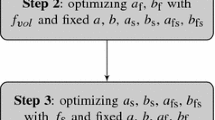Abstract
MRI-driven computational modeling is increasingly used to simulate in vivo cardiac mechanical behavior and estimate subject-specific myocardial stiffness. However, in vivo validation of these estimates is exceedingly difficult due to the lack of a known ground-truth in vivo myocardial stiffness. We have developed 3D-printed heart phantoms of known myocardium-mimicking stiffness and MRI relaxation properties and incorporated the heart phantoms within a highly controlled MRI-compatible setup to simulate in vivo diastolic filling. The setup enables the acquisition of experimental data needed to evaluate myocardial stiffness using computational constitutive modeling: phantom geometry, loading pressures, boundary conditions, and filling strains. The pressure-volume relationship obtained from the phantom setup was used to calibrate an in silico model of the heart phantom undergoing simulated diastolic filling. The model estimated stiffness was compared to a ground-truth stiffness obtained from uniaxial tensile testing. Ultimately, the setup is designed to enable extensive validation of MRI and FEM-based myocardial stiffness estimation frameworks.
Access this chapter
Tax calculation will be finalised at checkout
Purchases are for personal use only
Similar content being viewed by others
References
Heidenreich, P.A., et al.: Forecasting the impact of heart failure in the united states. Circ. Heart Fail. 6, 606–619 (2013)
Sakata, Y., Ohtani, T., Takeda, Y., Yamamoto, K., Mano, T.: Left ventricular stiffening as therapeutic target for heart failure with preserved ejection fraction. Circ. J. 77, 886–892 (2013)
Peirlinck, M., et al.: Using machine learning to characterize heart failure across the scales. Biomech. Model. Mechanobiol. 18, 1987–2001 (2019)
Burkhoff, D., Mirsky, I., Suga, H.: Assessment of systolic and diastolic ventricular properties via pressure-volume analysis: a guide for clinical, translational, and basic researchers. Am. J. Physiol. Heart Circ. Physiol. 289, H501–512 (2005)
Khan, S., Fakhouri, F., Majeed, W., Kolipaka, A.: Cardiovascular magnetic resonance elastography: a review. NMR Biomed. 31, (2018)
Wang, V.Y., Nielsen, P.M.F., Nash, M.P.: Image-based predictive modeling of heart mechanics. Annu. Rev. Biomed. Eng. 17, 351–383 (2015)
Cork, T.E., Perotti, L.E., Verzhbinsky, I.A., Loecher, M., Ennis, D.B.: In: Coudière, Y., Ozenne, V., Vigmond, E., Zemzemi, N. (eds.) Functional Imaging and Modeling of the Heart 2019. LNCS, vol. 11504, pp. 177–186. Springer, Cham (2019)
Dual, S.A., et al.: Ultrasonic sensor concept to fit a ventricular assist device cannula evaluated using geometrically accurate heart phantoms. Artif. Organs 43, 467–477 (2019)
Schneider, F., Draheim, J., Kamberger, R., Wallrabe, U.: Process and material properties of polydimethylsiloxane (PDMS) for optical MEMS. Sens. Actuators A Phys. 151, 95–99 (2009)
Johnston, I.D., McCluskey, D.K., Tan, C.K.L., Tracey, M.C.: Mechanical characterization of bulk Sylgard 184 for microfluidics and microengineering. J. Micromech. Microeng. 24, (2014)
Peirlinck, M., et al.: Kinematic boundary conditions substantially impact in silico ventricular function. Int. J. Numer. Methods Biomed. Eng. 35, (2019)
Jones, E., Oliphant, T., Peterson, P.: SciPy: open source scientific tools for python (2001)
Sommer, G., et al.: Biomechanical properties and microstructure of human ventricular myocardium. Acta Biomater. 24, 172–192 (2015)
von Knobelsdorff-Brenkenhoff, F., et al.: Myocardial T1 and T2 mapping at 3 T: reference values, influencing factors and implications. J. Cardiovasc. Magn. Reson. 15, 53 (2013)
Palchesko, R.N., Zhang, L., Sun, Y., Feinberg, A.W.: Development of polydimethylsiloxane substrates with tunable elastic modulus to study cell mechanobiology in muscle and nerve. PLoS ONE 7, (2012)
Hopf, R., Bernardi, L., Menze, J., Zündel, M., Mazza, E., Ehret, A.E.: Experimental and theoretical analyses of the age-dependent large-strain behavior of Sylgard 184 (10:1) silicone elastomer. J. Mech. Behav. Biomed. Mater. 60, 425–437 (2016)
Acknowledgements
This work was supported by NIH R01 HL131823 to DBE.
Author information
Authors and Affiliations
Corresponding author
Editor information
Editors and Affiliations
Rights and permissions
Copyright information
© 2021 Springer Nature Switzerland AG
About this paper
Cite this paper
Kolawole, F.O. et al. (2021). A Framework for Evaluating Myocardial Stiffness Using 3D-Printed Heart Phantoms. In: Ennis, D.B., Perotti, L.E., Wang, V.Y. (eds) Functional Imaging and Modeling of the Heart. FIMH 2021. Lecture Notes in Computer Science(), vol 12738. Springer, Cham. https://doi.org/10.1007/978-3-030-78710-3_30
Download citation
DOI: https://doi.org/10.1007/978-3-030-78710-3_30
Published:
Publisher Name: Springer, Cham
Print ISBN: 978-3-030-78709-7
Online ISBN: 978-3-030-78710-3
eBook Packages: Computer ScienceComputer Science (R0)





